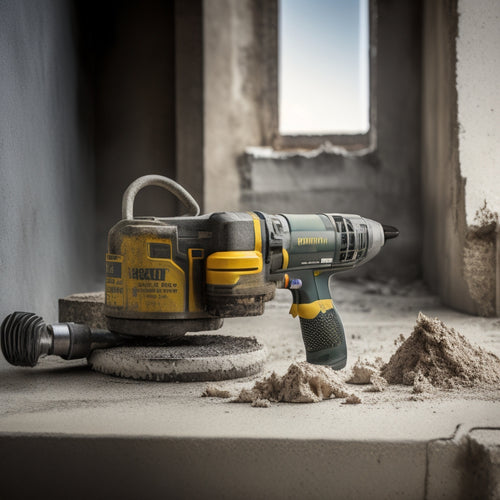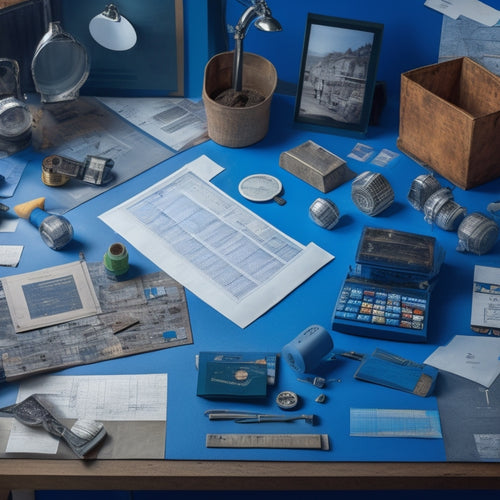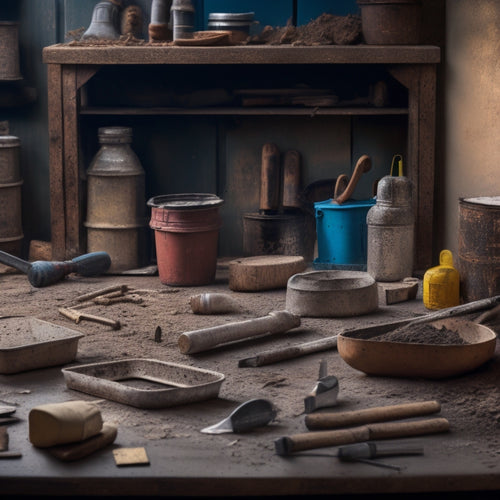
Stucco Tool Kit Checklist for Home Renovation
Share
You'll need a thorough stucco tool kit to guarantee a successful home renovation, as the right tools can make all the difference in achieving a professional-looking finish and avoiding costly mistakes. Your kit should include essential tools like putty knives, hawks, levels, and mixing buckets, as well as specialized trowels, edgers, and finishing tools like floats and darbies. Don't forget surface preparation tools, mixing equipment, safety gear, measuring and leveling tools, and cleaning items. With the right tools, you'll be well on your way to a stunning stucco finish - and the following guide will walk you through the specifics of what you need to know.
Key Takeaways
- A comprehensive stucco tool kit should include essential tools like putty knives, hawks, levels, and mixing buckets for stucco application.
- Trowels and edgers in various materials and sizes are necessary for applying and shaping stucco, while finishing tools help achieve a smooth surface finish.
- Surface preparation tools, such as scrapers and notch tools, ensure a strong bond between old and new stucco, and mixing equipment is crucial for achieving the perfect blend.
- Safety gear, including respirators, goggles, gloves, and protective clothing, is essential for protecting oneself from stucco-related hazards during home renovation.
- Measuring and leveling tools, like tape measures, laser levels, and digital levels, guarantee accurate and precise stucco application to prevent costly reworks.
Stucco Finishing Tool Kit Essentials
As you prepare to tackle a stucco finishing project, having the right tools is vital to achieving a professional-looking finish.
You'll need a putty knife for applying and smoothing out stucco, as well as a hawk for holding and carrying the material. A level and straightedge will guarantee your stucco application techniques are accurate and even.
Additionally, a mixing bucket and drill with a mixing paddle are necessary for combining the stucco mixture to the right consistency. Don't forget a spray bottle for misting the surface, which helps the stucco adhere properly.
To achieve a seamless color match, it's imperative to have color matching options available, such as stucco color charts or a color-matching app.
Other vital tools include a scratching tool for creating texture and a finishing float for achieving a smooth finish.
With these tools in your stucco finishing tool kit, you'll be well-equipped to tackle your project with confidence and achieve the professional-looking results you desire.
Must-Have Trowels and Edgers
You'll need to select the right trowel blades for your stucco project, considering factors like size, material, and finish.
Your edger handle options will also impact your work, with choices ranging from fixed to adjustable and ergonomic designs.
Trowel Blade Selection
What trowel blades do you really need to get the job done efficiently? When it comes to selecting the right trowel blades for your stucco project, you'll want to take into account the materials and sizes that will help you achieve a smooth, even finish.
Trowel blade materials are a vital factor in your selection process. You'll want to choose blades made from high-quality, durable materials such as stainless steel, carbon steel, or fiberglass. Each material has its own strengths and weaknesses, so reflect on the specific demands of your project when making your decision.
Trowel blade sizes are also important to getting the job done right. You'll need a range of blades in different sizes to accommodate various areas of your project, from tight spaces to large, open areas.
Common sizes include 4-inch, 6-inch, and 12-inch blades, but you may need larger or smaller sizes depending on your specific needs.
Edger Handle Options
When working with stucco, having the right edger handle options can make all the difference in achieving a professional-looking finish.
You'll want to evaluate the edger materials that best suit your needs. Edgers made from high-quality aluminum or stainless steel are durable and resistant to corrosion, ensuring they'll withstand the demands of your project.
You'll also need to choose from various edger styles, each designed for specific tasks. For instance, a flat-edged edger is ideal for scraping and smoothing out surfaces, while a rounded-edged edger is better suited for creating curved lines and profiles.
Additionally, evaluate the handle's grip and ergonomics, as a comfortable grip will reduce fatigue and improve control.
When selecting an edger handle, think about the type of stucco you're working with and the specific demands of your project.
With the right edger handle options, you'll be able to achieve a smooth, even finish that meets your high standards.
Finishing Floats and Darby Tools
You'll use finishing floats to achieve a smooth, even surface finish, typically after applying the second coat of stucco.
Darby tools, on the other hand, are long, flat tools used to remove excess material and create a uniform surface.
Float Surface Finishing
Finishing floats and darby tools play an essential role in float surface finishing, as they help achieve a smooth, even surface by removing excess material and imperfections.
You'll use these tools to refine the stucco surface, ensuring it's ready for the final coat of finish.
When it comes to float surface finishing, you'll need to master various float application techniques. These techniques involve holding and manipulating the float at different angles and pressures to achieve the desired texture and smoothness.
The type of float material you use will also impact the final result. You can choose from wood, magnesium, or resin floats, each with its own strengths and weaknesses.
For instance, wood floats are ideal for rough, textured surfaces, while magnesium floats are better suited for smooth, fine finishes.
Resin floats, on the other hand, offer a hybrid of both. By selecting the right float material and applying the correct techniques, you'll be able to achieve a professional-looking finish that's free of imperfections and excess material.
Darby Tool Uses
Three crucial darby tools in your stucco toolkit are the straight darby, the curved darby, and the notched darby. These tools are designed to help you achieve a smooth, even finish on your stucco surface.
You'll use the straight darby to flatten and smooth out the stucco, the curved darby to work around corners and curved areas, and the notched darby to create a textured finish.
Using darby tools provides several benefits, including increased efficiency and better results. They allow you to work with precision, making it easier to achieve a professional-looking finish.
Additionally, darby tools are designed to reduce fatigue, making them a beneficial asset for any stucco project.
To get the most out of your darby tools, it's crucial to maintain them properly. Clean them regularly to prevent stucco buildup, and store them in a dry place to prevent rust.
Finishing Float Techniques
As stucco application reaches its final stages, one essential step remains: achieving a smooth, even finish using finishing float techniques.
You've worked hard to get to this point, and now it's time to bring your stucco project to life with a flawless finish.
To perfect finishing float techniques, remember these key points:
-
Choose the right float material: Select from magnesium, resin, or foam floats, each suited for specific stucco types and desired finishes.
-
Apply the right amount of pressure: Too little pressure won't achieve a smooth finish, while too much can create imperfections.
-
Use the correct float application techniques: Hold the float at a 45-degree angle, applying gentle to moderate pressure, and work in small sections to maintain even coverage.
- Work in harmony with the stucco's texture: Adjust your float strokes to complement the stucco's natural texture, ensuring a seamless finish that enhances the overall appearance of your project.
Scrapers and Notch Tools Included
The stucco tool kit's scrapers and notch tools are designed to help you remove excess stucco and create precise joints and edges. When it comes to stucco application techniques, these tools are fundamental for achieving a smooth, even finish. You'll use scrapers to remove excess stucco and notch tools to create precise joints and edges.
Effective surface preparation is vital to a successful stucco application. Scrapers help you remove old stucco, dirt, and debris, ensuring a clean surface for new stucco. Notch tools, on the other hand, allow you to create precise joints and edges, which are essential for a strong and durable stucco finish.
In your stucco tool kit, you should have a variety of scrapers and notch tools, including flat scrapers, curved scrapers, and V-notched tools. These tools will help you tackle different surfaces and angles, ensuring a professional-looking finish.
Mixers and Paddle Accessories
You've prepared your surface and removed excess stucco with your scrapers and notch tools, now it's time to focus on mixing and applying the perfect stucco blend. This is where your mixers and paddle accessories come into play.
Having the right mixers and paddles can make all the difference in achieving a smooth, even finish.
- Electric mixers: ideal for large batches and heavy mixing
- Gas-powered mixers: perfect for remote locations or areas with limited power access
- Paddles made from durable materials like stainless steel or fiberglass: resistant to corrosion and wear
- Paddle extensions: allow for greater reach and reduced fatigue
When choosing your mixers and paddles, consider the size of your project, the type of stucco you're working with, and your personal comfort level.
With the right tools, you'll be able to mix and apply your stucco with ease, achieving a professional-looking finish that will last for years to come.
Safety Gear and Protective Wear
Frequently, stucco projects involve harsh materials and physical labor, making safety gear and protective wear essential components of your tool kit. You'll be working with materials that can cause skin irritation, respiratory issues, and eye damage, so it's vital to prioritize your safety.
When it comes to safety gear, you'll need:
| Safety Gear | Purpose |
|---|---|
| Respirator or dust mask | Respiratory protection from inhaling dust and debris |
| Safety goggles or glasses | Eye safety from flying particles and chemical splashes |
| Gloves | Protection from skin irritation and cuts from rough materials |
Measuring and Leveling Tools
From the get-go, accurate measurements and leveling are vital in stucco projects, as even slight deviations can lead to costly reworks and compromised structural integrity.
You can't afford to get it wrong, and that's why it's essential to have the right tools for the job.
To verify measurement techniques are on point, you'll need:
- A high-quality tape measure that can withstand harsh job site conditions
- A laser level for precise leveling accuracy and to detect even the slightest deviations
- A digital level for added precision and ease of use
- A combination square for verifying accurate 90-degree angles and precise markings
With these tools, you'll be able to tackle even the most complex stucco projects with confidence.
Remember, measurement and leveling accuracy are key to a successful stucco installation.
Don't compromise on quality – invest in the right tools to get the job done right the first time.
Cleaning and Maintenance Items
Accurate measurements and leveling set the stage for a successful stucco installation, but they're only half the battle. You'll need the right cleaning and maintenance items to guarantee a smooth application process and a long-lasting finish.
To keep your stucco tools in top condition, don't forget to include these essentials in your toolkit:
| Tool | Purpose |
|---|---|
| Soft-bristle brush | Remove dust and debris from tools and surfaces |
| Mild detergent | Clean stucco surfaces without damaging the finish |
| Water hose | Rinse tools and surfaces thoroughly |
| Lint-free cloth | Wipe down tools and surfaces to prevent water spots |
Follow these stucco cleaning and maintenance tips to guarantee a successful renovation:
- Clean your tools regularly to prevent stucco buildup and damage
- Avoid using harsh chemicals or abrasive materials that can damage the stucco finish
- Perform regular inspections to catch any potential issues early on
Specialized Stucco Add-Ons Needed
As you plunge deeper into your stucco project, incorporating specialized add-ons will raise your work to a professional level, ensuring a flawless finish and long-term durability.
These add-ons not only enhance the appearance of your stucco but also provide essential benefits like improved weather resistance and reduced maintenance.
To take your stucco project to the next level, consider the following specialized add-ons:
-
Stucco additives: These additives can be mixed with your stucco to provide benefits like increased strength, improved workability, and enhanced color retention. They can also reduce the risk of cracking and shrinkage.
-
Moisture barrier solutions: These solutions prevent water from seeping behind your stucco, reducing the risk of damage and ensuring a longer lifespan for your stucco.
-
Fibers and reinforcements: Adding fibers or reinforcements to your stucco can improve its tensile strength, reducing the risk of cracking and improving its overall durability.
- Acrylic finishes: These finishes provide a durable, water-resistant coating that can be colored to match your stucco, providing an attractive and low-maintenance finish.
Frequently Asked Questions
Can I Use a Stucco Tool Kit for Interior and Exterior Projects?
You can use a stucco tool kit for both interior and exterior projects, as it's designed for versatility; however, you'll want to prioritize interior applications for smooth finishes and exterior durability for withstanding harsh weather conditions.
Are Stucco Tool Kits Suitable for DIY or Professional Use Only?
You'll find stucco tool kits suitable for both DIY and professional use, as they're designed to excel in various stucco techniques, and their tool durability guarantees they withstand frequent use, giving you the freedom to tackle projects with confidence.
Can I Purchase Individual Tools Instead of a Complete Kit?
You're free to forge your own path, forgoing the kit for à la carte tools. Individual tool benefits include customized selection and potential cost savings; however, compare prices carefully to guarantee you're not sacrificing convenience for cash.
How Often Should I Clean and Maintain My Stucco Tools?
You should clean your stucco tools after each use and perform deep maintenance every 1-3 months, depending on usage, to prevent rust and guarantee peak performance; regular cleaning frequency and proper maintenance tips will extend tool lifespan and save you time.
Are Stucco Tool Kits Compatible With Different Types of Stucco Mixes?
You'll find that stucco tool kits often vary in their compatibility with different stucco mixes, so it's crucial to research the specific tool kit you're using to verify it's compatible with your chosen mix, as some kits cater to specific mix types.
Conclusion
Now that you've got your stucco tool kit checklist in hand, you're ready to tackle that home renovation project like a pro. Remember, a well-stocked toolkit is like a skilled chef's secret ingredient - it's the key to whipping up a flawless finish. With these essentials on board, you'll be serving up a stucco masterpiece that'll make the neighbors green with envy.
Related Posts
-

Top Drill for Concrete Wall Renovation
When choosing the top drill for your concrete wall renovation, you'll want to prioritize key features like drill powe...
-

5 Best Home Renovation Project Timeline Checklists
You're looking for a clear understanding of the timeline for your home renovation project. A good place to start is w...
-

Trowel Tool Cost for DIY Home Renovation Projects
When it comes to your DIY home renovation project, you'll need to budget for a variety of trowel tools, including stu...


